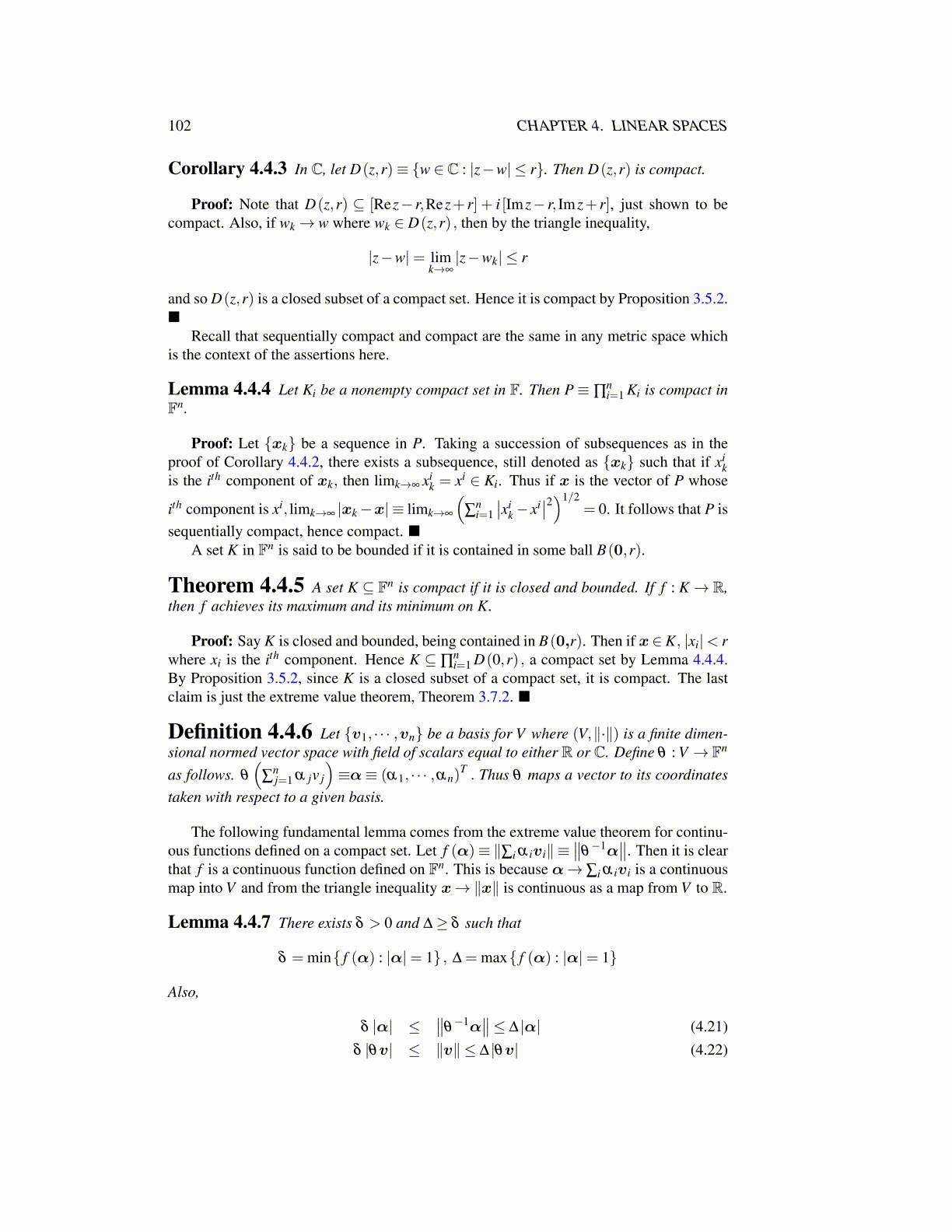
102 CHAPTER 4. LINEAR SPACES
Corollary 4.4.3 In C, let D(z,r)≡ {w ∈ C : |z−w| ≤ r}. Then D(z,r) is compact.
Proof: Note that D(z,r) ⊆ [Rez− r,Rez+ r] + i [Imz− r, Imz+ r], just shown to becompact. Also, if wk→ w where wk ∈ D(z,r) , then by the triangle inequality,
|z−w|= limk→∞
|z−wk| ≤ r
and so D(z,r) is a closed subset of a compact set. Hence it is compact by Proposition 3.5.2.■
Recall that sequentially compact and compact are the same in any metric space whichis the context of the assertions here.
Lemma 4.4.4 Let Ki be a nonempty compact set in F. Then P≡ ∏ni=1 Ki is compact in
Fn.
Proof: Let {xk} be a sequence in P. Taking a succession of subsequences as in theproof of Corollary 4.4.2, there exists a subsequence, still denoted as {xk} such that if xi
kis the ith component of xk, then limk→∞ xi
k = xi ∈ Ki. Thus if x is the vector of P whose
ith component is xi, limk→∞ |xk−x| ≡ limk→∞
(∑
ni=1
∣∣xik− xi
∣∣2)1/2= 0. It follows that P is
sequentially compact, hence compact. ■A set K in Fn is said to be bounded if it is contained in some ball B(0,r).
Theorem 4.4.5 A set K ⊆ Fn is compact if it is closed and bounded. If f : K→ R,then f achieves its maximum and its minimum on K.
Proof: Say K is closed and bounded, being contained in B(0,r). Then if x∈K, |xi|< rwhere xi is the ith component. Hence K ⊆ ∏
ni=1 D(0,r) , a compact set by Lemma 4.4.4.
By Proposition 3.5.2, since K is a closed subset of a compact set, it is compact. The lastclaim is just the extreme value theorem, Theorem 3.7.2. ■
Definition 4.4.6 Let {v1, · · · ,vn} be a basis for V where (V,∥·∥) is a finite dimen-sional normed vector space with field of scalars equal to either R or C. Define θ : V → Fn
as follows. θ
(∑
nj=1 α jv j
)≡α≡ (α1, · · · ,αn)
T . Thus θ maps a vector to its coordinatestaken with respect to a given basis.
The following fundamental lemma comes from the extreme value theorem for continu-ous functions defined on a compact set. Let f (α)≡ ∥∑i α ivi∥ ≡
∥∥θ−1α
∥∥. Then it is clearthat f is a continuous function defined on Fn. This is because α→ ∑i α ivi is a continuousmap into V and from the triangle inequality x→∥x∥ is continuous as a map from V to R.
Lemma 4.4.7 There exists δ > 0 and ∆≥ δ such that
δ = min{ f (α) : |α|= 1} , ∆ = max{ f (α) : |α|= 1}
Also,
δ |α| ≤∥∥θ−1α
∥∥≤ ∆ |α| (4.21)δ |θv| ≤ ∥v∥ ≤ ∆ |θv| (4.22)